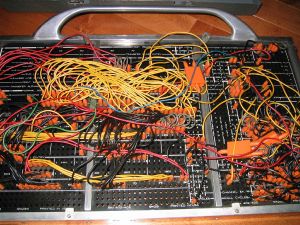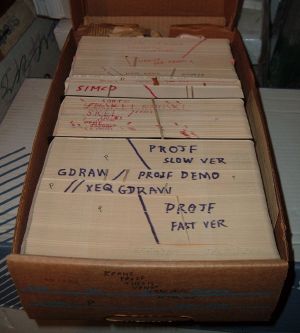Computer programming
- "Programming" redirects here.
Computer programming (often simply programming or coding) is the craft of writing a set of commands or instructions that can later be compiled and/or interpreted and then inherently transformed to an executable that an electronic machine can execute or "run". Programming requires mainly logic, but has elements of science, mathematics, engineering, and — many would argue — art.[1]
In software engineering, programming (implementation) is regarded as one phase in a software development process.
Programming languages
The programming language that a computer can directly execute is machine language (sometimes called "machine code"). Originally all programmers worked out every detail of the machine code, but this is hardly ever done anymore. Instead, programmers write source code, and a computer (running a compiler, an interpreter or occasionally an assembler) translates it through one or more translation steps to fill in all the details, before the final machine code is executed on the target computer. Even when complete low-level control of the target computer is required, programmers write assembly language, whose instructions are mnemonic one-to-one transcriptions of the corresponding machine language instructions. People that do the programming are called computer programmers. Programmers must write, test, and give instructions to programs to perform a function.
Different programming languages support different styles of programming (called programming paradigms). Common languages are C++ and Java but there are many more. Part of the art of programming is selecting one of the programming languages best suited for the task at hand. Different programming languages require different levels of detail to be handled by the programmer when implementing algorithms, often in a compromise between ease of use and performance (a trade-off between "programmer time" and "computer time").
In some languages, an interpretable p-code binary (or byte-code) is generated, rather than machine language. Bytecode is used in the popular Java programming language by Sun Microsystems as well as Microsoft's recent .NET family of languages (MS.NET's P-Code is called the Intermediate Language or IL) and Visual Basic previous to the .NET version.
Brief History of Programming
The earliest programmable machine (that is, a machine that can adjust its capabilities based upon changing its "program") can be said to be the Jacquard Loom, which was developed in 1801. The machine used a series of pasteboard cards with holes punched in them. The hole pattern represented the pattern that the loom had to follow in weaving cloth. The loom could produce entirely different weaves using different sets of cards. This innovation was later refined by Herman Hollerith of IBM in the development of the famous IBM punch card. These were used with a variety of machines called unit record equipment to perform data processing tasks. The unit record equipment were programmed by changing the wiring of plug-boards. Early computers used similar programming methods.
The invention of the Von Neumann architecture allowed programs to be stored in computer memory. Early programs had to be painstakingly crafted using the instructions of the particular machine, often in binary notation. Every model of computer would be likely to need different instructions to do the same task. Later assembly languages were developed that let the programmer specify each instruction in a text format, entering abbreviations for each operation code instead of a number and specifying addresses in symbolic form (e.g. ADD X, TOTAL). In 1954 Fortran, the first higher level programming language, was invented. This allowed programmers to specify calculations by entering a formula directly (e.g. Y = X**2 + 5*X + 9). The program test, or source, was converted into machine instructions using a special program called a compiler. Many other languages were developed, including ones for commercial programming, such as COBOL. Programs were mostly still entered using punch cards or paper tape. See computer programming in the punch card era. In the mid-1970s, mass storage devices and computer terminals became inexpensive enough so programs could be created by typing directly into the computers. Text editors were developed that allowed changes and corrections to be made much more easily than with punch cards.
As time has progressed computers have made giant leaps in the area of processing power. This has brought about newer programing languages that are more abstracted from the underlying hardware. Although these more abstracted languages require additional overhead, in most cases the huge increase in speed of modern computers has brought about little performance decrease compared to earlier counterparts. The benefits of these more abstracted languages is that they allow both an easier learning curve for people less familiar with the older lower-level programming languages, and they also allow a more experienced programmer to develop simple applications quickly. Despite these benefits, large complicated programs, and programs that are more dependent on speed still require the faster and relatively lower-level languages with todays hardware. (The same concerns were raised about the original Fortran language.)
Throughout the second half of the twentieth century, programming was an attractive career in most developed countries. Some forms of programming have been increasingly subject to offshore outsourcing (importing software and services from other countries, usually at a lower wage), making programming career decisions in developed countries more complicated, while increasing economic opportunities in less developed areas. It is unclear how far this trend will continue and how deeply it will impact programmer wages and opportunities.
Examples of computer programming languages
In an almost evolutionary order
- FORTRAN is a general-purpose, procedural, imperative programming language that is especially suited to numeric computation and scientific computing. Originally developed by John Backus of International Business Machines Corporation (IBM) in the 1950s for scientific and engineering applications.
- C is a compiled procedural, imperative programming language made popular as the basis of Unix.
- Shell scripting, in particular using either a variant of the Bourne shell or the C shell, is popular among UNIX hackers. Although the exact implementation varies among different shells, the core principles remain intact: only providing facilities for program flow (also seen in C) while placing emphasis on using external programs, although most shells feature some other functions internally, known as builtins. Shell scripting is used primarily in systems administration, especially where tasks need to be automated and run at specific times (backups, monitoring, file system maintenance, among others). It is also used as a tool for rapid prototyping when the exact design of a program is not yet clear enough for a full implementation, often in a compiled language like C. Whilst most shell scripts are relatively simple it is possible to create complex and powerful programs in many implementations.
- SMALLTALK invented 1971 was the most important fundament for object oriented programming. It started a new programming paradigm, which influenced the whole art of programming significantly. Smalltalk is a pure object oriented (OO) language with a minimalistic syntax. This is possible because very consequent mostly everything is done inside the class library. Even standard control structures are implemented in the class library. There exists nothing else than objects. Not many other OO-languages have this clearness and simplicity.
- Pascal is a general-purpose structured language named after the famous mathematician and philosopher Blaise Pascal. It was very popular during the '80s and '90s. Whilst popularity of Pascal itself has waned (its principal use is in teaching of programming) languages derived from it (such as Object Pascal) are still in use.
- BASIC (Beginner's All purpose Symbolic Instruction Code) was invented by John Kemeny and Thomas Kurtz of Dartmouth College. It became the most widely used language when microcomputers first hit the market, in the '70s and '80s. Many dialects of BASIC have been produced. Because early dialects lacked important features such as strong data typing, procedures and functions, BASIC was typically seen as a language for learning programming and prototyping rather than for enterprise development. This is not true today since many BASIC compilers offer all of the structured programming advantages as other languages.
- Visual Basic is Microsoft's implementation of BASIC as an integrated development environment.
- C++ is a compiled programming language based on C, with support for object-oriented programming. It is one of the most widely-used programming languages currently available. It is often considered to be the industry-standard language of game development, but is also very often used to write other types of computer software applications. C++ was developed by Bjarne Stroustrup and was based on the programming language C. C++ retains the syntax and many familiar functions of C, but also adds various concepts associated with other programming paradigms, such as classes.
- C# is an object-oriented programming language developed by Microsoft as part of their .NET initiative. C# has a procedural, object oriented syntax based on C++ that includes aspects of several other programming languages (most notably Delphi,Visual Basic, and Java) with a particular emphasis on simplification (less symbolic requirements than C++, less decorative requirements than Java). Though developed by Microsoft, C# is standardized by the ECMA and International Standards Organization.
- Java is an object oriented interpreted programming language. It has gained popularity in the past few years for its ability to be run on many platforms, including Solaris, Linux, Microsoft Windows, Mac OS and other systems. It was developed by Sun Microsystems.
- Lisp is a family of functional, sometimes scripted, programming languages often used in AI.
- Object Pascal is an object oriented derivative of Pascal. Developed by Apple Computer in the 1980s, today it is primarily known as the language of Borland Delphi. It is also used with Kylix, Chrome and various open source object pascal implementations, such as FreePascal.
- The Delphi Language is the name of the Object Pascal derivative that is the primary language of later versions of Borland's Delphi Studio integrated development environment.
- Perl one of the first widely-used, cross-platform, interpreted languages, Perl owes much of its syntax and semantics to C and the Unix shell.
- Python is an interpreted, dynamically typed, object-oriented language that has some unique syntax features (like the significance of indentation). Though strictly speaking an interpreted language, its usage domain follows that of Java and C#.
- Ruby is very much like Python, though it features some constructs more closely related to those found in Perl and Lisp. It is also the basis of a very popular web application framework named Ruby on Rails.
- PHP is a newer programming language with focus on web design. It has a C-like syntax.
Software development
Software is a mass noun for computer programs and data. The accompanying documentation and software license are also considered an essential part of the software, even though they don't involve any actual coding.
Creating software involves:
- Requirements analysis
- Specification
- Software architecture
- Coding
- Compilation
- Software testing
- Documentation
- Integration
- Maintenance
Notes
- ↑ Paul Graham (2003). "Hackers and Painters". Retrieved 2006-08-22.
See also
- Algorithm
- Software development process
- Programming Language
- Computer programming in the punch card era
External links
- Computer Programming WikiBooks
- Windows Programming WikiBooks
- 1999 article on software programmer demographics
- Detailed timeline on history of programming languages
- IAENG International Journal of Computer Science
- Web Based Programming Tutorials
- Article covering the basic concepts common to most, if not all, programming languages
Credits
New World Encyclopedia writers and editors rewrote and completed the Wikipedia article in accordance with New World Encyclopedia standards. This article abides by terms of the Creative Commons CC-by-sa 3.0 License (CC-by-sa), which may be used and disseminated with proper attribution. Credit is due under the terms of this license that can reference both the New World Encyclopedia contributors and the selfless volunteer contributors of the Wikimedia Foundation. To cite this article click here for a list of acceptable citing formats.The history of earlier contributions by wikipedians is accessible to researchers here:
The history of this article since it was imported to New World Encyclopedia:
Note: Some restrictions may apply to use of individual images which are separately licensed.

